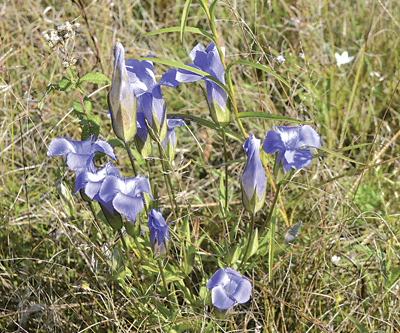RARE INDIANA HABITAT RESTORED, ONE SEED AT A TIME
 Restoring a habitat that’s been disturbed by farming or industry to its natural state is hard work. For Duff Lake Fen in Lagrange County, that means controlling invasive species, replicating natural stream course, and reseeding areas in need of a boost. Habitat restoration needs seed—lots of it—to regenerate native species.
Restoring a habitat that’s been disturbed by farming or industry to its natural state is hard work. For Duff Lake Fen in Lagrange County, that means controlling invasive species, replicating natural stream course, and reseeding areas in need of a boost. Habitat restoration needs seed—lots of it—to regenerate native species.
However, native seed doesn’t come in little white packets. It can’t be purchased easily from the local home and garden center. And for cash-strapped nonprofits doing yeoman’s work, native seed of local genotype is not only difficult to obtain, but cost prohibitive to buy.
When faced with the years-long restoration effort of Duff Lake Fen, Blue Heron Ministries, a nonprofit conservation organization based in Angola, turned to what was already in the soil. Within Duff Lake Fen is a true sedge meadow. Similar to the plight of Indiana prairies, wet prairies, and other fens, less than one percent of these “sun-drenched” habitats remain. Helping the fen survive means borrowing from what the land is already producing: twig rush, spotted joe pye weed, mountain mint, tall ironweed, and Riddells’ goldenrod.
It’s one of those early fall mornings: cool and sunny. Classic October in Indiana. Blue Heron Ministries recruited help, and volunteers from the Northeast Chapter of the Indiana Native Plant and Wildflower Society (NEINPAWS) joined the effort. For Kate Sanders, stewardship chair for NEINPAWS, collecting seed is a kind of spiritual adventure. “We all descended from hunter-gatherer societies, so collecting seed is an innate experience that comes back,” Sanders says. “The world stops and all you hear is the wind rustling through the vegetation. The process is simultaneously powerful and peaceful.” Some plants’ seed is ready to collect. Others will have to wait until the seed has matured.
On this day, the group was thrilled to see uncommon plants, like Kalm’s Lobelia, fringed gentian, and grass of Parnassus. Sanders notes that species like these are a good sign for the Duff Lake Fen restoration because they are habitat specific. “The seed for these plants was here before European settlement. It’s still in the soil,” Sanders says. “We just need to give the plants an opportunity to grow again.” For Blue Heron Ministries, that means controlling invasive species, like reed canary grass, and replenishing areas with collected native seed.
The reseeding work improves habitat that attracts species that are equally as endangered. Mitchell’s saytr, a butterfly, and the shy eastern massasagua rattlesnake, the only rattlesnake indigenous to northern Indiana, depend on habitats like Duff Lake Fen. As a biologist, Sanders believes in restoring land and encourages everyone to give seed collecting a try. “We always see something absolutely stunning.
There’s always a treasure,” Sanders says. “A rare orchid. A spiderweb sprinkled with dew in the morning sunlight. When I collect seed, I feel like I’m receiving a gift.”
For more information about Blue Heron Ministries, visit blueheronministries.org. To learn about upcoming NEINPAWS events, email Kim at neinpaws@gmail.com or visit facebook.com/NortheastINPAWS.
- RARE SCHOOL WOODLAND PROPERTY GAINS NEW SUPPORT - April 14, 2017
- AN URBAN PRAIRIE IN WAYNEDALE - January 20, 2017
- RARE INDIANA HABITAT RESTORED, ONE SEED AT A TIME - November 4, 2016


